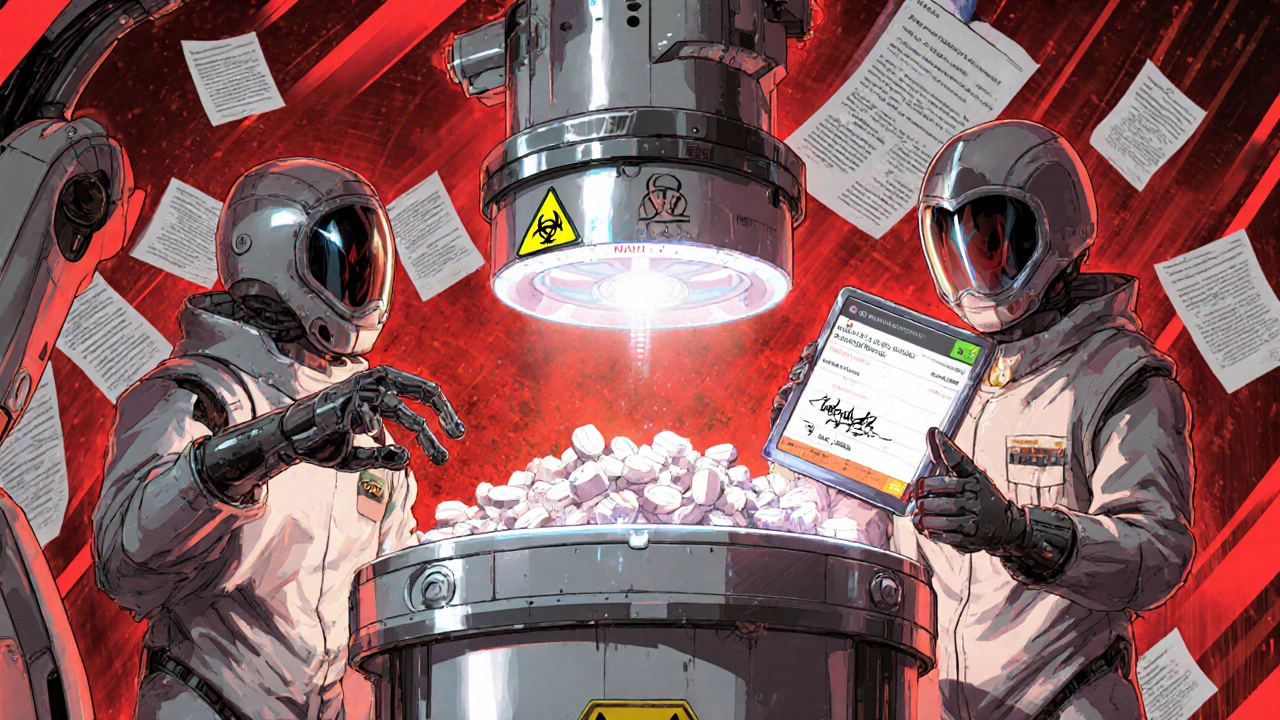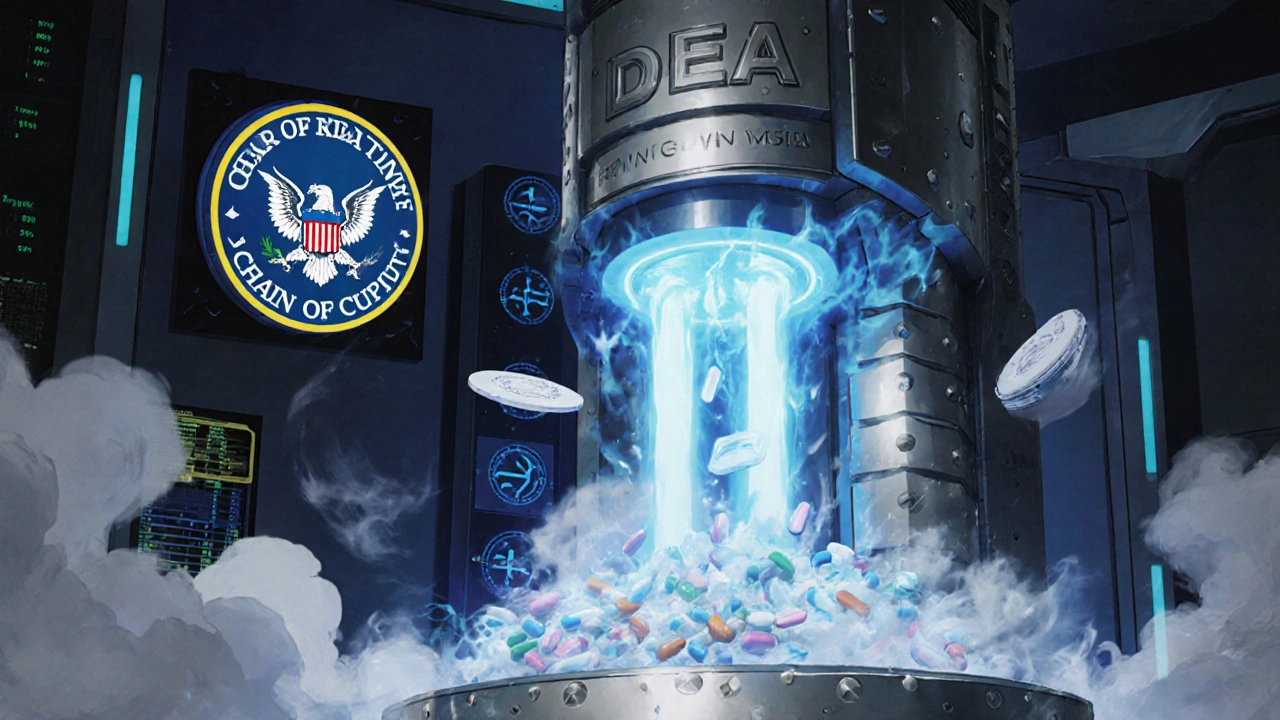Expired controlled substances aren’t just old pills gathering dust in a cabinet-they’re legal liabilities, environmental hazards, and potential sources of addiction if they fall into the wrong hands. Whether you’re a pharmacist, a vet, a hospital worker, or a researcher handling opioids, benzodiazepines, or other Schedule II-V drugs, disposing of expired controlled substances isn’t optional. It’s a federal requirement enforced by the DEA, with serious penalties for getting it wrong.
Why You Can’t Just Throw Them Away
You might think tossing expired painkillers in the trash or flushing them down the toilet is harmless. It’s not. The DEA explicitly bans these methods for controlled substances. Why? Because even expired drugs can still be potent. A 2022 DEA audit found that 14% of diverted prescription opioids came from improperly discarded stock in healthcare settings. That’s not just a statistic-it’s someone’s relapse waiting to happen. Unlike regular over-the-counter meds, where mixing with coffee grounds or kitty litter is sometimes acceptable, controlled substances must be rendered non-retrievable. That means no one-not a curious teenager, not a scavenger, not even a lab technician-can recover usable drug from the waste. The only method the DEA has approved to meet this standard is incineration.What Counts as a Controlled Substance?
Not all expired meds are the same. The DEA classifies them into five schedules based on abuse potential and medical use:- Schedule I: No accepted medical use (e.g., heroin, LSD)-rarely handled outside research labs.
- Schedule II: High abuse risk, severe dependence (e.g., oxycodone, fentanyl, Adderall, morphine).
- Schedule III: Moderate to low abuse risk (e.g., hydrocodone with acetaminophen, ketamine).
- Schedule IV: Low abuse risk (e.g., alprazolam, diazepam, tramadol).
- Schedule V: Minimal abuse potential (e.g., cough syrups with limited codeine).
The stricter the schedule, the tighter the rules. Schedule II drugs require the most documentation and oversight. Even a single expired fentanyl patch must be tracked and destroyed properly.
Two Types of Disposal: Inventory vs. Wastage
The DEA makes a critical distinction between two kinds of disposal:- Inventory disposal: When you’re getting rid of entire stockpiles-expired vials, unused syringes, old bottles. This is for larger quantities, often from pharmacy stock or lab reserves.
- Wastage: Small amounts left over after preparing a dose-like the last 2 mL in a vial you couldn’t give to a patient, or a crushed tablet that didn’t fully dissolve.
Inventory disposal requires a reverse distributor. Wastage can sometimes be handled in-house-but only under strict conditions.
How to Dispose of Inventory (Large Quantities)
If you’re clearing out expired stock, you must use a DEA-registered reverse distributor. These are licensed companies that collect, transport, and incinerate controlled substances. You cannot dispose of them yourself.Here’s how it works:
- Label everything clearly. Mark expired or unusable drugs with “DO NOT USE,” “EXPIRED,” or “TO BE DISPOSED.” Keep them segregated from active inventory in a locked, secure area.
- Complete DEA Form 222 (for Schedule II only). As of January 1, 2023, this must be done electronically via the DEA’s Electronic Registration System (ERS). Paper forms are no longer accepted. Processing time dropped from over a week to under 2 days since the switch.
- Contract with a reverse distributor. Companies like Stericycle, Daniels Health, or Drug and Laboratory Disposal, Inc. (DLD) handle pickups. Fees range from $250 to $500 per pickup, depending on volume and location.
- Document the chain of custody. Every transfer must be logged. You’ll need a signed chain-of-custody form from the distributor. Keep copies for at least two years.
- Update your inventory log. Remove the disposed items from your controlled substance inventory. Zero out the balance. Failure to do this is one of the most common violations found in DEA inspections.
University of Michigan’s research labs reported an average wait time of 14.7 business days for a pickup. Plan ahead. Don’t wait until your storage closet is overflowing.

How to Handle Wastage (Small Amounts)
Wastage happens daily in clinical settings. You can dispose of small amounts in-house-but only if you follow a strict two-person witness protocol.Steps for in-house wastage disposal:
- Two authorized personnel must be present. One must be the DEA registrant or their direct agent. The other can be a licensed pharmacist, nurse, or vet. Both must witness the destruction.
- Destroy the substance immediately. Pour liquid waste into a designated, labeled container that’s then sealed and incinerated. Solid waste (like crushed tablets) must be mixed with an irreversible denaturing agent-such as activated charcoal or proprietary neutralizing solutions-and placed in a secure sharps or biohazard container.
- Record everything. Log the date, drug name, quantity, method, and names of both witnesses. Sign and date the entry. This record must be kept for two years.
Important: You cannot use kitty litter, coffee grounds, or blue disposal pads for controlled substances. The FDA says these methods are fine for regular meds-but the DEA says they’re illegal for narcotics. Even a tiny amount of oxycodone residue in kitty litter is a violation.
Documentation Is Non-Negotiable
The DEA doesn’t just want you to dispose of drugs-they want proof you did it right. Every disposal, whether inventory or wastage, must be documented. Missing logs are the #1 reason clinics get fined.Required records include:
- Date of disposal
- Drug name and strength
- Quantity disposed
- Method of disposal
- Name and signature of both witnesses (for wastage)
- Reverse distributor receipt and DEA Form 222 copy (for inventory)
These logs must be stored securely and made available for inspection. The DEA conducted 1,847 disposal inspections in 2022 and issued 327 warning letters-mostly for incomplete or missing records.
Training and Compliance
Every person who handles controlled substances must be trained. The DEA requires:- Initial 2-hour training on disposal procedures
- Annual 1-hour refresher
But here’s the problem: a 2022 audit found only 67% of facilities met this requirement. If you’re not training your staff, you’re not compliant. And if you’re not compliant, you’re at risk of losing your DEA registration-meaning you can’t legally prescribe or store controlled substances anymore.
Some institutions, like UCSF, use digital systems like Research Inventory Online (RIO) to automate tracking. These systems reduce errors by over 80% compared to paper logs. Smaller practices still rely on handwritten forms-and those have an 18.7% error rate, according to the DEA.

What About Veterinary Practices?
Veterinarians are among the most at-risk groups for improper disposal. A 2022 survey by the American Animal Hospital Association found that 44% of small animal clinics were confused about disposal rules. Many still flush drugs or throw them in the trash.But the rules are the same: no flushing, no trash, no kitty litter. Schedule II drugs like morphine or hydromorphone require reverse distributors. Schedule III-V drugs can sometimes be disposed of in-house with two witnesses.
Good news: the DEA’s online disposal locator tool, updated in November 2022, helps vets find nearby reverse distributors. 77% of users found it helpful. Use it.
What’s Changing Soon?
The DEA is rolling out the Electronic Inventory Management System (EIMS) by 2025. This will require real-time reporting of all disposals-no more waiting weeks to file paperwork. You’ll need to log every destroyed pill, every wasted vial, as it happens.Why? Because opioid deaths haven’t stopped. In 2023, the DEA’s National Take Back Day collected nearly 900,000 pounds of medication-up 8% from the year before. Public awareness is growing. Enforcement is tightening.
By 2027, the DEA expects 93% of healthcare facilities to be fully compliant. If you’re not on track, you’re falling behind.
What Happens If You Don’t Follow the Rules?
Penalties aren’t warnings-they’re financial and professional ruin.- Fines: Up to $10,000 per violation
- License suspension: You can lose your DEA registration
- Criminal charges: For intentional diversion or falsifying records
In 2022, the DEA collected $2.47 million in fines from disposal violations alone. That’s not a fine-it’s a warning.
One dental office in Ohio lost its DEA registration after a disposal log was missing for six months. They couldn’t prescribe opioids anymore. Their patients had to find new providers. Their business dropped 60% in six months.
Bottom Line: Do It Right, Every Time
Expired controlled substances aren’t trash. They’re dangerous materials that demand respect. The rules exist for a reason: to protect patients, prevent addiction, and keep communities safe.Don’t guess. Don’t cut corners. Don’t rely on outdated advice.
Here’s your checklist:
- Label expired drugs clearly and separate them from active stock.
- Know if you’re dealing with inventory (reverse distributor) or wastage (two-person witness).
- Never flush, throw in trash, or use kitty litter.
- Document every single disposal-date, drug, quantity, witness, method.
- Keep records for two years.
- Train your staff annually.
- Use digital systems if you can-they reduce errors and save time.
Compliance isn’t optional. It’s the bare minimum. If you’re handling these drugs, you’re responsible for what happens to them-even after they’re expired.
Can I dispose of expired controlled substances in the regular trash?
No. The DEA strictly prohibits disposing of any controlled substance in household or medical trash. Even expired opioids, benzodiazepines, or stimulants can be recovered and misused. Only incineration by a DEA-registered reverse distributor or in-house destruction under strict witness protocols is allowed.
Is it legal to flush expired painkillers down the toilet?
No. Flushing is never permitted for controlled substances, even if the FDA recommends it for some non-controlled medications. The DEA explicitly states that flushing controlled drugs poses a risk of environmental contamination and drug diversion. This applies to all schedules, including Schedule III-V drugs.
What’s the difference between Schedule II and Schedule IV disposal rules?
Schedule II drugs (like oxycodone or fentanyl) require DEA Form 222 and must be transferred to a reverse distributor for incineration. Schedule IV drugs (like alprazolam) can sometimes be disposed of in-house using a two-witness wastage procedure if the quantity is small. However, both require full documentation and two-year record retention.
Do I need training to dispose of controlled substances?
Yes. The DEA requires all personnel handling controlled substances to complete an initial 2-hour training and annual 1-hour refresher. Failure to train staff is a common violation that can lead to fines or loss of DEA registration. Training must cover proper disposal methods, documentation, and chain of custody.
How long do I need to keep disposal records?
You must retain all disposal records-including waste logs, chain-of-custody forms, and DEA Form 222 copies-for at least two years. DEA inspectors routinely request these during audits. Missing or incomplete records are among the top reasons for enforcement actions.
Can I use kitty litter or coffee grounds to dispose of expired narcotics?
No. While these methods are sometimes acceptable for non-controlled medications, the DEA explicitly forbids them for all controlled substances. Even small amounts of opioids or sedatives can be recovered from kitty litter or coffee grounds, making this a violation of federal law.
What should I do if I find expired controlled substances in a patient’s home?
You cannot legally take possession of drugs from a patient’s home unless you’re a registered reverse distributor or authorized law enforcement. Direct patients to DEA-authorized take-back locations, such as pharmacies or police stations with drop boxes. You can also guide them to the DEA’s online disposal locator tool.
Are there free disposal options for small practices?
There are no free disposal options for controlled substances. Reverse distributors charge fees, typically $250-$500 per pickup. Some states or local health departments offer subsidized programs for small clinics or veterinary practices-check with your state pharmacy board. Otherwise, budget for disposal as a necessary operational cost.

Just ran a disposal audit at my clinic. Two-person witness protocol saved us from a DEA fine. Document everything. No exceptions.